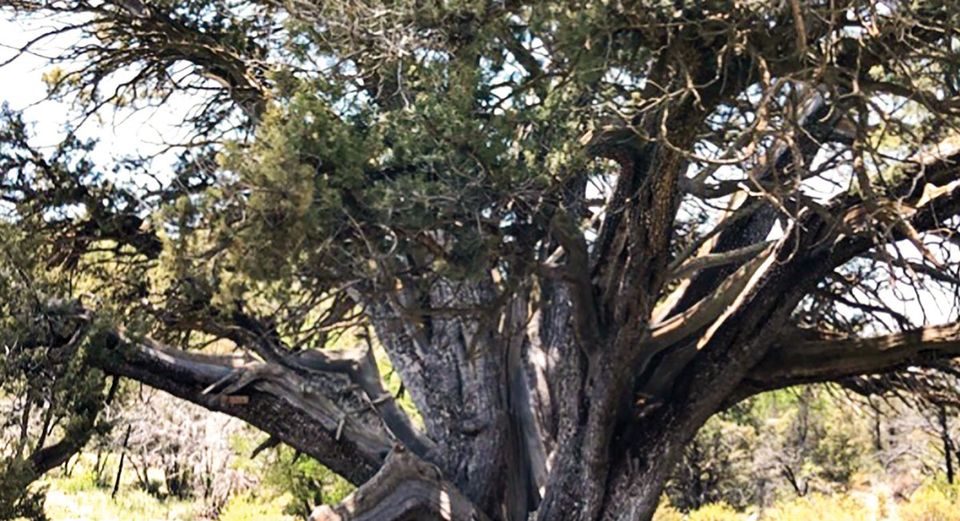THERE ARE ALLIGATORS IN THE SOUTHWEST!

Did you know that alligators are common in the Southwest and that the largest population of alligators can be found in Arizona? Take a walk along the Mogollon Rim in Arizona sometime and you’re guaranteed an alligator encounter. Probably more than one. As a matter of fact, Show Low city park swarms with them. But don’t be afraid, these alligators don’t bite. They’re trees.
Officially Juniperus deppeana, the alligator juniper gets its name because of its scaly bark that resembles the skin of an alligator. These trees share their home in the rocky soils and arid steeps of the mountains at 4,500 to 10,000-feet elevations along with Ponderosa pines, piñons, oaks and other junipers. Hearty, tenacious, drought resistant, slow growing and long lived, there is much to admire about these magnificent trees.
They’re not beautiful in the way of a towering Ponderosa or a spreading oak but they have a beauty that’s embedded in their twisted limbs and scarred bodies that imparts a sense of struggle and wisdom. Prescott, Arizona is home to one of the largest recorded alligators in the world. It’s called “Old Grandfather” and is reported to be somewhere between 500 and 2,000-years-old. Junipers, due to the nature of their branching, are difficult to date but, because of their slow growth, it can be assumed the larger their girth, the greater their age. “Old Grandfather” stands 46 feet tall and is 27 feet 4 inches around. It became rather famous back in 2013 when the Granite Mountain Hotshots saved it from an approaching wildfire. The crew had what was to be their last photo taken together astride the branches of the old juniper. One week later, all but one of the crew was killed in a different fire.
No matter what size alligator juniper you encounter, it’s more than likely to be older than you. Trees are said to be the keepers of nature’s memory and the alligators have long ones. There’s a beautiful old alligator not far from where I live. In some places, it’s lost its alligator scales and a smooth soft grey under skin is exposed. It’s twisted from blowing winds and sports the scars from at least one fire and one lightning strike. It is riddled with holes that have become homes for birds. Some of its limbs stretch barren toward the sky; some still are adorned in bristly juniper greenery. I’ve never seen it bear the trademark blue juniper berries of its kind so it’s either too old or it’s a male. I avoid it in the spring (I’ll tell you why later) so I don’t know if it produces pollen. One thing I can be certain of is that it’s most likely somewhere between three- and five-hundred-years-old. Imagine!
The United States of America did not yet exist when that tree first sprouted. Somehow, in the ensuing years, it survived untold blizzards, droughts and forest fires. It managed to escape being stomped by the passing of different groups of native Americans and the hooves of the horses of Conquistadors searching for lost cities of gold. As it grew, it evaded becoming firewood or fence posts for the incoming settlers of the area. In all that time, it provided shelter and food for countless wildlife. Smaller junipers erupt at its feet and cling to the rocky slopes beneath it. Its progeny? It’s all there. History, memorialized in the roots, trunk and canopy of that ancient tree. If only we could talk with it!
But not in the spring. Sometime between February and April, the alligators start their siren song of love in the form of pollen. Junipers are notorious for making the most allergy-producing pollen in the Southwest. It can be seen floating as a yellow haze in the air on a warm spring morning when the junipers “puff.” At that time, this most admired tree becomes the most cursed tree by its human neighbors.
The rest of the year though, the spicy scent and purple berries of our mighty Southwestern alligators are a soothing and sought-after remedy for modern day woes. So, next time you’re out hiking in the Southwest, look for the alligator skinned tree with the massive memory and take a moment to pause and offer a few words of praise.











